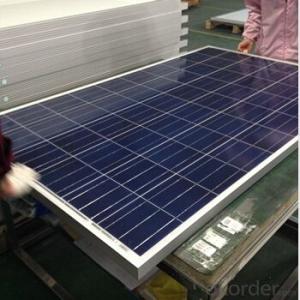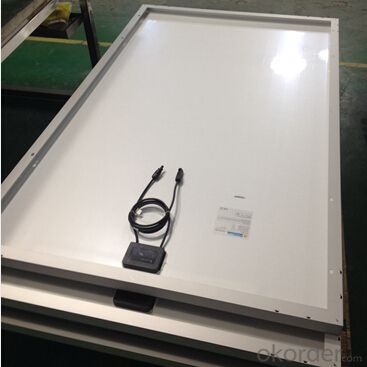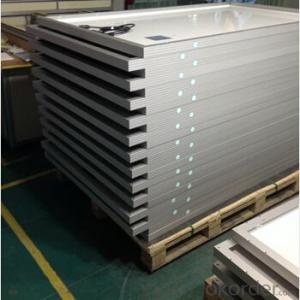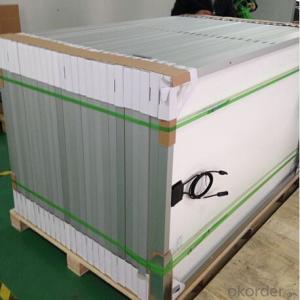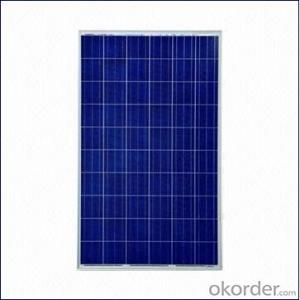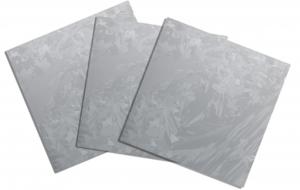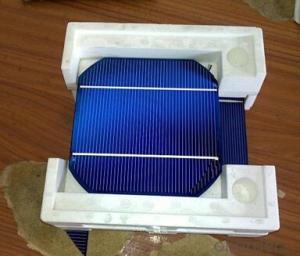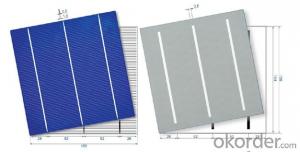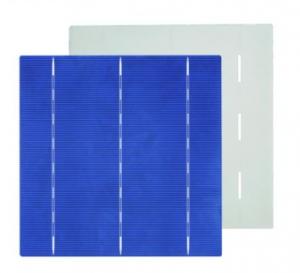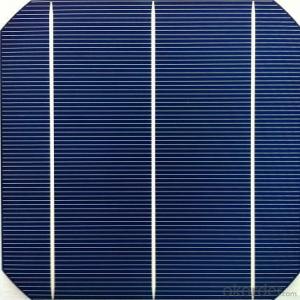Wafer Based Polycrystalline Solar Panels for 240W - 156*156 Poly Cell
- Loading Port:
- Shanghai
- Payment Terms:
- TT OR LC
- Min Order Qty:
- 25 pc
- Supply Capability:
- 100000 pc/month
OKorder Service Pledge
OKorder Financial Service
You Might Also Like
Specifications:
Structure of Polycrystalline Solar Panel
Polycrystalline Solar Panel : High efficiency crystalline solar cell.
Even if under the weak light, the solar module can produce maximum power output.
II Tempered glass (toughened glass): Anti-reflecting coating and high transmission rate glass increase the power output and mechanical strength of solar module.
III EVA and TPT: Using high quality EVA and TPT to prevent destroying and water.
IV AI frame: Without screw, rner connection. 6 holes on the frame can be installed easily.
V Junction box: Multi function junction box with water proof.
VI Long lifetime: ≥25 years; Less power decrease.
VII Good performance of preventing from atrocious weather such as wind and hails.
VIII Resisting moisture and etching effectively, not effected by geology.
IX The certificate issued by international authority: UL, TUV, IEC, CE.
Standard Test Conditions of Polycrystalline Silicon Solar Panel:
The opto-electrical specifications shown below are stabilized values being measured at Standard Test Conditions, Irradiance: 1000W/m2, Spectrum: AM1.5 at 25°C, The info below is subject to manufacturing tolerances.
Where appropriate minutes of measurement are available and are used for the dimensioning of the installation.
Advantages of Monocrystalline Silicon Solar Panel
• CNBM Solar performance guarantees for 25 years
• 12 years guarantee for workmanship
• Timeliness of delivery
• Quality Products certified (TÜV, UL, CE, ISO)
Technical date :
ITEM NO.: | Poly 156*156 cell ,60pcs . Power range from 230Wp-260Wp | ||||||
Maximum Power(W) | 230 | 235 | 240 | 245 | 250 | 255 | 260 |
Optimum Power Voltage(Vmp) | 29.4 | 29.5 | 29.7 | 30.1 | 30.3 | 30.5 | 30.7 |
Optimum Operatige Current(Imp) | 7.83 | 7.97 | 8.08 | 8.14 | 8.25 | 8.37 | 8.48 |
Open Circuit Voltage(Voc) | 36.7 | 36.8 | 36.9 | 37.1 | 37.3 | 37.5 | 37.7 |
Short Circuit Current(Isc) | 8.52 | 8.59 | 8.62 | 8.65 | 8.69 | 8.73 | 8.78 |
Solar Cell: | 156*156 Poly | ||||||
Number of Cell(pcs) | 6*10 | ||||||
Name of Solar Cells | Polycrystalline Cell | ||||||
Size of Module(mm) | 1650*992*40/45/50 | ||||||
Cable & Connector Type | Pass the TUV Certificate | ||||||
Frame(Material Corners,etc.) | Aluminium-alloy | ||||||
Back sheet | TPT | ||||||
Weight Per Piece(KG) | 19.5KG | ||||||
FF (%) | 70-76% | ||||||
Junction Box Type | Pass the TUV Certificate | ||||||
Tolerance Wattage(e.g.+/-5%) | ±3%, or 0-3% | ||||||
Front Glass Thickness(mm) | 3.2 | ||||||
Temperature Coefficients of Isc(%) | +0.04 | ||||||
Temperature Coefficients of Voc(%) | -0.38 | ||||||
Temperature Coefficients of Pm(%) | -0.47 | ||||||
Temperature Coefficients of Im(%) | +0.04 | ||||||
Temperature Coefficients of Vm(%) | -0.38 | ||||||
Temperature Range | -40°C to +85°C | ||||||
Surface Maximum Load Capacity | 5400Pa | ||||||
Allowable Hail Load | 23m/s ,7.53g | ||||||
Bypass Diode Rating(A) | 12 | ||||||
Warranty | 90% of 10 years, 80% of 25 years. | ||||||
Standard Test Conditions | AM1.5 1000W/ 25 +/-2°C | ||||||
Packing | carton or pallet | ||||||
1*20' | 14 Pallets / 316pcs | ||||||
1*40'STD | 25 Pallets / 700pcs | ||||||
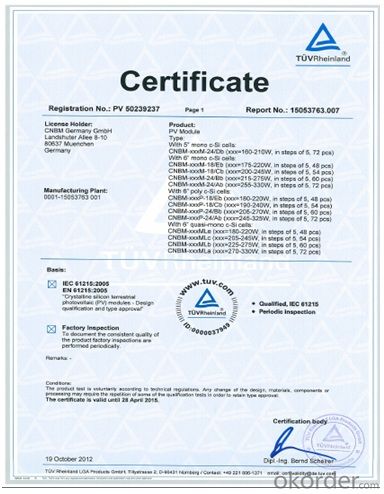
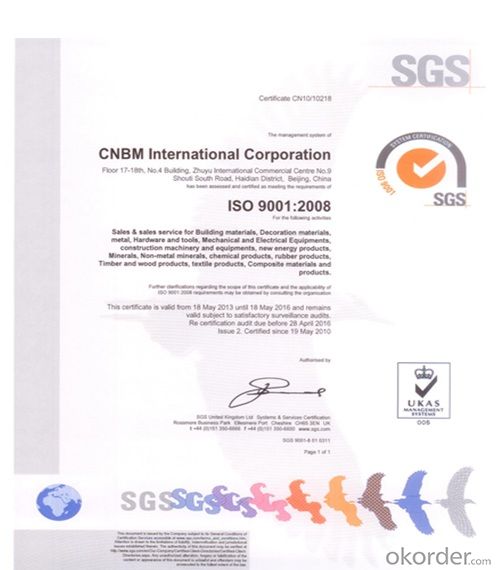


FAQ
We have organized several common questions for our clients,may help you sincerely:
①What price for each watt?
It depends on the quantity, delivery date and payment terms,
②What is your size for each module? Can you tell me the Parameter of your module?
We have different series of panels in different output, both c-Si and a-Si. Please take the specification sheet for your reference.
③Can you provide the peripheral products of the solar panels, such as the battery, controller, and inverter? If so, can you tell me how do they match each other?
Yes, we can, we have two companies for solar region, one is CNBM International, the other is CNBM engineering Co.
We can provide you not only the solar module but also the off grid solar system, we can also provide you service with on grid plant.
④What is your warranty system?
Our product performance guarantees for 25 years
• 12 years guarantee for workmanship
• Timeliness of delivery
• Quality Products certified (TÜV, UL, CE, ISO)
⑤How do you pack your products?
We have rich experience on how to pack the panels to make sure the safety on shipment when it arrives at the destination.
⑥ Can you do OEM for us?
Yes, we can.
- Q: How long is the long cycle solar cell life?
- Various solar cells according to its working principle, life is different (1) silicon solar cells Silicon solar cells are divided into three kinds of monocrystalline silicon solar cells, polycrystalline silicon thin film solar cells and amorphous silicon thin film solar cells.
- Q: What is a polycrystalline solar cell?
- A polycrystalline solar cell is a type of solar cell made from multiple crystal structures, resulting in a grainy appearance. It is less expensive to produce compared to monocrystalline cells, but typically has lower efficiency levels.
- Q: Can solar cells be used in agriculture for irrigation?
- Yes, solar cells can be used in agriculture for irrigation. Solar-powered water pumps can be used to draw water from wells or other sources, providing a reliable and sustainable solution for irrigation. This helps farmers reduce their dependence on traditional energy sources and decrease operational costs, making solar cells a viable option for agricultural irrigation.
- Q: What is the impact of fire hazards on solar cells?
- Fire hazards can have a significant impact on solar cells, as they are highly susceptible to damage and destruction when exposed to fire. The extreme heat generated by fires can melt or deform the delicate components of solar cells, rendering them useless. Additionally, smoke and soot particles can accumulate on the surface of solar panels, reducing their efficiency by blocking sunlight. Therefore, fire hazards pose a serious threat to the functionality and lifespan of solar cells.
- Q: How does the photovoltaic cells work?
- Photovoltaic solar cells fulfill two functions: photogeneration of charge carriers (electrons and holes) in a light-absorbing material, and separation of the charge carriers to a conductive contact that will transmit the electricity.
- Q: How do solar cells perform in areas with high levels of air pollution?
- Solar cells can experience a decrease in performance in areas with high levels of air pollution due to reduced sunlight reaching the surface of the cells. The presence of pollutants in the atmosphere can block or scatter sunlight, leading to a decrease in the amount of energy that can be converted by the solar cells.
- Q: Can solar cells be used in space stations?
- Yes, solar cells can be used in space stations. In fact, they are commonly used to provide power to space stations by converting sunlight into electricity.
- Q: Can solar cells be used for desalination purposes?
- Yes, solar cells can be used for desalination purposes. Solar-powered desalination systems, such as solar stills and solar desalination plants, harness the energy from the sun to power the desalination process. This renewable energy source helps reduce the environmental impact of desalination and promotes sustainable water production.
- Q: Can solar cells be used for powering remote sensing devices?
- Yes, solar cells can be used for powering remote sensing devices. Solar cells convert sunlight into electricity, making them an ideal power source for remote sensing devices that are often located in areas without access to traditional power grids. Additionally, solar cells are renewable and environmentally friendly, making them a sustainable option for powering these devices.
- Q: How are solar cells used in agricultural applications?
- Solar cells are used in agricultural applications to power various equipment and systems, such as irrigation pumps, water heaters, and electric fences. They provide a sustainable and renewable energy source that helps farmers reduce their dependence on fossil fuels and reduce operational costs. Solar cells also contribute to mitigating greenhouse gas emissions and promoting environmental sustainability in agriculture.
Send your message to us
Wafer Based Polycrystalline Solar Panels for 240W - 156*156 Poly Cell
- Loading Port:
- Shanghai
- Payment Terms:
- TT OR LC
- Min Order Qty:
- 25 pc
- Supply Capability:
- 100000 pc/month
OKorder Service Pledge
OKorder Financial Service
Similar products
Hot products
Hot Searches
Related keywords
